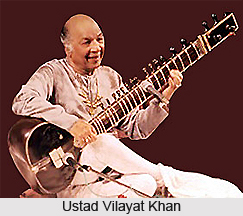 Vilayat Khan (August 28, 1928 [1]-March 13, 2004) was born in Gauripur. He was the son of Enayat Khan, a sitar maestro. He was taught in the family style, known as the Imdadkhani Gharana or Etawah Gharana, after a village outside Agra where Imdad Khan lived.
Vilayat Khan (August 28, 1928 [1]-March 13, 2004) was born in Gauripur. He was the son of Enayat Khan, a sitar maestro. He was taught in the family style, known as the Imdadkhani Gharana or Etawah Gharana, after a village outside Agra where Imdad Khan lived.
Vilayat Khan performed at All bengal Music Conference, as his first concert, organized by Bhupen Ghosh in Kolkata with Ahmed Jan Thirakwa on tabla. In the 1950s, he worked closely with instrument makers, especially Kanailal & Hiren Roy, to develop the instrument.
He re interpreted some of which include Bhankar, Jaijaivanti. Some of other ragas invented by himself that include Enayatkhani Kanada, Sanjh Saravali, Kalavanti, Mand Bhairav. He was a traditional interpreter of grand, basic ragas like Yaman, Shree, Todi, Darbari and Bhairavi.
He was probably the first Indian musician to play in England post independence (1951). He has performed concerts with maestros like Ustad Bismillah Khan, Ali Akbar Khan and brother Imrat Khan.
Khan composed and conducted the score for three feature films - Satyajit Ray`s Jalsaghar in Bengali, Merchant-Ivory Productions` The Guru in English, and Madhusudan Kumar`s Kadambari in Hindi.
He had spent much of his life living in Calcutta. He was married twice. He had two daughters Zila Khan and Yaman Khan, and two sons, Shujaat and Hidayat.
While continuing the tradition of his grandfather and his father, it was Vilayat who placed his gharana on the fundamentals of fame on which it rests assuredly. This he achieved by bringing his style of playing closer to the human voice. Credit goes to him for having introduced the gayaki-ang into the sitar. In fact, it was he who pioneered this move several decades back, at least in the field of stringed instruments that are plucked. Even his grandfather and father followed the instrumental idiom, or the tantkari style of playing. Vilayat Khan went ahead and re-engineered, redesigned and returned the sitar completely, in order that it may become the apt instrument capable of reproducing every vocal shade he wished it to. The changes he fashioned on the sitar are nothing short of radical. He completely did away with the steel kharaj strings, used for rendering the lower octave, with brass strings which produce a higher pitch. These he turned to the key notes of the raaga. The chief melody string had a higher pitch than the one used by those following Senia or Maihar styles.
The mandra saptak could not be attempted at all in this sitar as those strings were removed to make way for treble strings. The deep veena-like effects are wholly absent in this baaj. But what was lost in terms of range, Vilayat gained in terms of tunefulness. The chikari or the drone strings became tonally more prominent, as they began to function like a tanpura, providing a sense of continuity. In other words, while the Maihar and Senia instrumentalists capture the grandeur of dhrupad gayaki in all the octaves, the Vilayatkhani baaj devotedly echoes the fascinating tonalities of khayal and thumri. The gayaki-ang he fashioned, replicates the aesthetic and emotional profusion of vocal music.




















